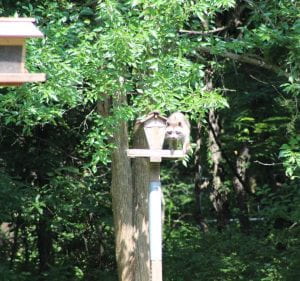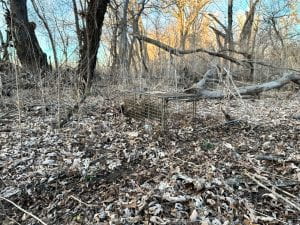Drew Ricketts, wildlife management and control specialist
 Raccoons are very intelligent, resourceful animals that often live around farmyards in hollow trees, holes created by other animals, brush piles, abandoned vehicles and farm machinery, and buildings. Raccoons are omnivorous, meaning that their diet is very diverse and can include plant material such as fruits and nuts, animal matter from earthworms and insects to reptiles, amphibians, small mammals and birds. While raccoons are fascinating animals, their broad diet, intelligence, and willingness to live close to humans can lead to conflicts with people and pets and the need for some form of control.
Raccoons are very intelligent, resourceful animals that often live around farmyards in hollow trees, holes created by other animals, brush piles, abandoned vehicles and farm machinery, and buildings. Raccoons are omnivorous, meaning that their diet is very diverse and can include plant material such as fruits and nuts, animal matter from earthworms and insects to reptiles, amphibians, small mammals and birds. While raccoons are fascinating animals, their broad diet, intelligence, and willingness to live close to humans can lead to conflicts with people and pets and the need for some form of control.
As with most wildlife species, we don’t know exactly how many raccoons there are in KS, but we do have a very good idea of the trend in their abundance throughout the state because of long-term records kept by Kansas Department of Wildlife and Parks (KDWP). For furbearing animals, like raccoons, KDWP has developed a survey by having employees record the number of animals of each species that they see (dead or alive) while driving for their daily activities during a specific time of the year, and then correcting the count by the number of miles driven by those employees.
A couple of trends about raccoons in KS are very clear from the Roadside Index. First, the species can be found throughout the state, and densities increase as water and trees become more common from west to east. Second, raccoons have become more abundant during the last 30 to 40 years. In fact, the roadside index for raccoons has increased from about 2 in 1980 to approximately 8 in 2023! While this doesn’t necessarily mean that there are 4 times more raccoons in KS now than there were in 1980, there are definitely more, and there are likely more raccoons in the state now than there ever have been. The obvious cause for the increase in their abundance is reduced harvest by trappers and hunters since the fur market crash of the late 1980s, but several other factors associated with settlement of the Great Plains are also probably important including fewer predators and increased habitat from tree planting and fire prevention.
More raccoons living in areas occupied by people, or the resources we care about, leads to more conflicts. Because of this, many folks are grasping for options to manage problems with raccoons on their own. Sometimes, the solution is as simple as not feeding pets free choice outdoors, removing bird or other wildlife feeders, or securing trash containers, as these food sources often attract raccoons that can cause problems. However, when raccoons have made homes in buildings, are causing significant crop damage, killing poultry, or damaging livestock food sources, they may need to be removed. Wildlife professionals do not recommend moving problem animals around on the landscape, because of the risk of spreading diseases, passing a problem on to someone else, and low survival of the individuals moved. Therefore, it is more appropriate to euthanize the animals that need to be removed. A quick search on the internet for “how to kill raccoons” turns up all sorts of options, but it may be hard to know which options are humane, ethical, and legal.
Many states, including Kansas, have a statute that allows removal of animals that are causing property damage, as long as they are not federally protected by the Endangered Species Act, Migratory Bird Treaty Act, or a state protected species. Raccoons are a furbearing animal in KS, so there is a season on their harvest, but landowners, legal occupants, or a Nuisance Wildlife Control Operator (NWCO) may use lethal means to remedy a problem that they are causing outside of the legal season and without a license to harvest as long as they use a legal method of take and do not try to utilize the animal that has been removed. A licensed NWCO in KS can make use of animals taken outside of season because of property damage that they are causing. One challenge after doing that internet search that I mentioned earlier is determining what methods of take are legal.
There are no registered pesticides for raccoons, opossums, skunks, armadillos or any similar species in Kansas. It is illegal to place fly bait, rodenticides, or any other product with the intent to kill raccoons. If these products will kill raccoons effectively, then why is it illegal, and why shouldn’t you do it? There are too many reasons (a lot of them legal issues) to cover here, but one of the main, common sense, reasons that we have restrictions like this is that we need to be able to target the species that we are intending to control, and it is nearly impossible to put out a product that smells and tastes good enough for a raccoon to consume a lethal dose without also exposing non-target wildlife, pets, livestock, and even people to that product. In addition to being illegal, it is unethical to place a poison in an indiscriminate way, especially when there are options available that are humane, relatively easy to implement, and are highly selective.

Raccoons are quite easy to trap using equipment that either excludes non-target species or makes it easy to release them unharmed. My trap type of choice for raccoons in areas with no restrictions on trap type is called a dog-proof raccoon trap, and is an enclosed foothold trap design. They are typically made out of round or square metal tubing with the trigger recessed a couple of inches down into the trap tube, and a support stake protruding from the bottom of the trap. The design prevents the self-mutilation that raccoons are prone to when caught in standard foothold trap designs, and excludes most non-target captures. However, opossums and skunks can access and work the trigger mechanism and are sometimes caught. Some domestic cats can also be caught, but proper bait selection makes it quite easy to use dog-proof traps to catch raccoons in the presence of cats. The key is to use a bait like dry cereal with marshmallows that raccoons will select, but does not attract domestic cats. When trapping raccoons in the presence of cats, avoid using baits with fish or meat smells, as these are just as attractive to pets as they are to raccoons. Dog-proof traps need to be anchored with a stake, or cable wrapped around an immovable object or large drag. When trapping in cold temperatures where the ground may freeze, avoid inserting the support stake on the dog-proof into the soil, as serious injuries can occur to trapped animals when the trap does not move freely after capture.

Municipalities often have restrictions on trap types that require cage traps to be used, or may even prevent homeowners from conducting their own trapping within city limits, so always check local laws before beginning a wildlife control program. Fortunately, raccoons are relatively easy to capture in cage traps that have a door opening of 10 x 11 inches or larger and are 2 to 3 feet long. If no domestic cats are present, canned cat food or sardines are both easily accessible baits that will attract raccoons. If cats are present, there are many commercially produced raccoon lures and baits with strong sweet smells that will attract raccoons. Cereals with marshmallows or marshmallows alone can be effective, but it can be more challenging to get a raccoon to enter a cage trap than to eat from a pipe in the open. Cage traps need to be set on firm, level ground, and can be stabilized by adding a heavy object to the top of the trap. Cage traps are also the most appropriate trap to use inside of structures.
With any trapping program, it is important to set traps where the animals are already present. To do this, look for areas with tracks, scat, other sign of the animal’s presence, or areas where the animal is seen frequently.
Traps must be checked every 24 hours, and trapped raccoons can be humanely dispatched with a gunshot to the head. However, animals caught in town may need to be transported outside of the city limits where discharging a firearm is legal.
Kansas residents experiencing raccoon damage have several options for receiving assistance with lethal control efforts. Local trappers and hunters are often happy for the opportunity to harvest raccoons on new properties, especially during the Kansas furbearer season from mid-November to mid-February. There are also many NWCOs throughout the state who will provide wildlife damage control assistance for a fee. A list of NWCOs, their location, and the species that they control may be found here. The Wildlife Damage Control Act of 1972 directs K-State Research and Extension to conduct a statewide program in wildlife damage control. Through this program, the Extension Wildlife Specialist is available to provide training to farmers and ranchers in effective control techniques and provide, on loan, control equipment not readily available. Contact information for the Extension Wildlife specialist can be found here.
For additional information on wildlife management, please visit the KSRE Wildlife Management website.